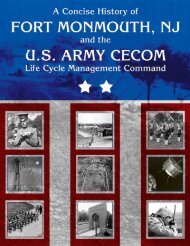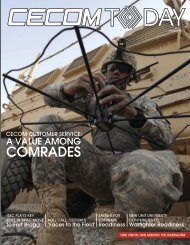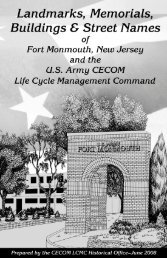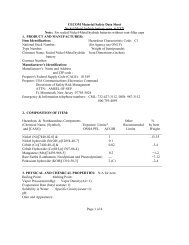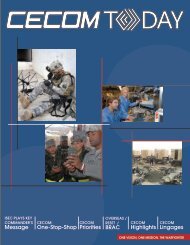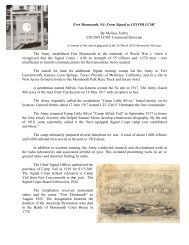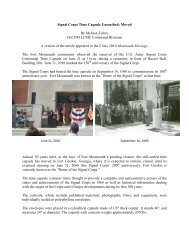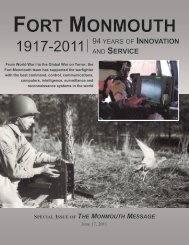A History of the Commanding Officers at Fort Monmouth ... - CECOM
A History of the Commanding Officers at Fort Monmouth ... - CECOM
A History of the Commanding Officers at Fort Monmouth ... - CECOM
You also want an ePaper? Increase the reach of your titles
YUMPU automatically turns print PDFs into web optimized ePapers that Google loves.
Brief <strong>History</strong> <strong>of</strong> <strong>Fort</strong> <strong>Monmouth</strong>(1917-present)With <strong>the</strong> authoriz<strong>at</strong>ion <strong>of</strong> <strong>the</strong> Adjutant General <strong>of</strong> <strong>the</strong> Army, (<strong>the</strong>n) LTCCarl F. Hartmann leased 468 acres <strong>of</strong> wh<strong>at</strong> is now known as <strong>Fort</strong><strong>Monmouth</strong>’s “Main Post” from Melvin Van Keuren <strong>of</strong> E<strong>at</strong>ontown on 16May 1917 with an option to buy. The land, a pot<strong>at</strong>o farm <strong>at</strong> <strong>the</strong> time,was considered an ideal loc<strong>at</strong>ion as it was close to both river andrail transport<strong>at</strong>ion.The first 32 Signal Soldiers arrived <strong>at</strong> <strong>Fort</strong> <strong>Monmouth</strong> in June 1917.The install<strong>at</strong>ion was originally named “Camp Little Silver,” basedmerely on its loc<strong>at</strong>ion. General Orders d<strong>at</strong>ed 17 June 1917 named LTCHartmann <strong>the</strong> first commander.“Camp Little Silver” became“Camp Alfred Vail” shortlyafter its establishment. TheChief Signal Officer <strong>the</strong>nauthorized <strong>the</strong> purchase <strong>of</strong>Camp Vail in 1919. TheSignal Corps Schoolreloc<strong>at</strong>ed to Camp Vail from<strong>Fort</strong> Leavenworth th<strong>at</strong> year,and <strong>the</strong> Signal Corps Boardfollowed in 1924.Camp Little Silver, 1917The install<strong>at</strong>ion received permanent st<strong>at</strong>us and was renamed <strong>Fort</strong><strong>Monmouth</strong> in August 1925. Th<strong>at</strong> design<strong>at</strong>ion honored <strong>the</strong> Soldiers<strong>of</strong> <strong>the</strong> American Revolution who died in <strong>the</strong> b<strong>at</strong>tle <strong>of</strong> <strong>Monmouth</strong>Court House.The Army erected <strong>the</strong> first permanent structure <strong>at</strong> <strong>Fort</strong> <strong>Monmouth</strong>, abarracks building on Barker Circle, in 1928. Russel Hall, now GarrisonHeadquarters, would be completed in 1936.The forerunner <strong>of</strong> <strong>the</strong> Army Air Corps and <strong>the</strong> U.S. Air Force had itsroots here. Air squadrons flew from <strong>the</strong> airfield in <strong>the</strong> 400 area.Innov<strong>at</strong>ive meteorological experiments occurred; for example, <strong>the</strong> firstradio-equipped meteorological balloon soared into <strong>the</strong> upper reaches<strong>of</strong> <strong>the</strong> <strong>at</strong>mosphere in 1928, a forerunner to <strong>the</strong> wea<strong>the</strong>r soundingtechnique used universally today.37/38 .



